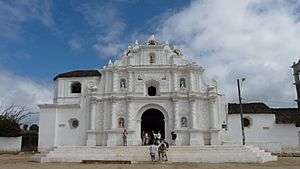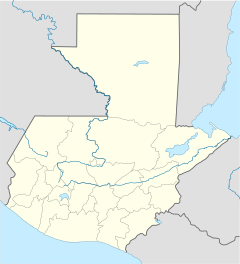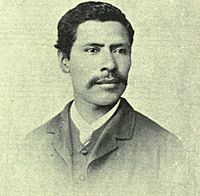San Juan Comalapa facts for kids
Quick facts for kids
San Juan Comalapa
|
|
|---|---|
|
Municipality and town
|
|

Church, San Juan Comalapa
|
|
| Country | |
| Department | |
| Area | |
| • Total | 48 sq mi (125 km2) |
| Population
(2018)
|
|
| • Total | 48,597 |
| • Density | 1,007/sq mi (388.8/km2) |
| Time zone | UTC+6 (Central Time) |
| Climate | Cwb |
San Juan Comalapa is a town and a municipality in the Chimaltenango department of Guatemala. In 2018, about 48,597 people lived there.
This town is sometimes called the "Florence of America." This is because many Kaqchikel painters live and work there. One famous painter from Comalapa is Paula Nicho Cumez. San Juan Comalapa is also the birthplace of Rafael Álvarez Ovalle, who wrote the music for Guatemala's national anthem.
The town's painting tradition began in the 1930s. A Kaqchikel painter named Andrés Curruchich (1891–1969) started painting with oil. His art became very popular, and he showed his work in the United States. Curruchiche decided to teach his painting style to younger artists. Today, there are around 500 painters in San Juan Comalapa. Most of them still use Curruchiche's techniques. These artists paint the traditional clothes, daily life, and customs of the local Indigenous towns.
Contents
History of San Juan Comalapa
Spanish Colonial Times
In the 1500s, during the Spanish conquest of Guatemala, a battle happened near a lake. The Spanish and their Kaqchikel allies won against the Tz'utujils. After the Spanish took control, Franciscans, a type of Catholic priest, built a church and monastery in Panajachel. They used this town to teach the local Indigenous people about the Roman Catholic faith. The front of this old church is still standing. It is a beautiful example of colonial style in Guatemala.
San Juan Comalapa was managed by the Franciscans. They had churches and taught their faith in many areas. These areas are now the departments of Sacatepéquez, Chimaltenango, Sololá, Quetzaltenango, Totonicapán, Suchitepéquez, and Escuintla. The Franciscan area was called "Provincia del Santísimo Nombre de Jesús" (Province of the Most Holy Name of Jesus). It had up to 24 convents. By 1700, San Juan Comalapa had a convent with three priests. They were in charge of about 1,800 people, one teaching center, and eight cofradías (religious brotherhoods).
Because there was a convent, daily Mass was held. Leaders of the cofradías and their wives attended, holding lighted candles. Also, every day, there was religious teaching. Girls aged 6 and older had class at 2:00 pm. Boys of the same age had class at sunset. These classes lasted two hours. Students memorized church teachings and prayers. They also did exercises with the catechism (a book of religious instruction). A priest or older Indigenous people called "fiscales" led the classes. Adults went to Mass every Sunday and on holidays. After Mass, they received religious teachings in their own language.
Lent was a special time when the friars prepared the Indigenous people very carefully. They used the people's own language to teach them. Every Friday during Lent, there was a procession. People followed the steps of the Rosary all the way to the Calvary temple.
In 1754, the Franciscans had to give their teaching centers to the secular clergy (priests not part of a religious order). This was part of the borbon reforms. So, when Archbishop Pedro Cortés y Larraz visited Panajachel in 1770, he described it as a curato (a parish managed by a secular priest).
The 20th Century
The town was badly damaged by the 1976 Guatemala earthquake. San Juan Comalapa is home to the longest mural in Guatemala. This mural shows the town's history. It starts from before the Spanish arrived, goes through colonization, the earthquake, and the Guatemalan civil war, up to today.
Friendship Cities
San Juan Comalapa has a special connection with the city of Stord in Norway. They are known as friendship cities.
Climate
San Juan Comalapa has a subtropical highland climate. This type of climate is called Cwb by the Köppen climate classification.
| Climate data for San Juan Comalapa | |||||||||||||
|---|---|---|---|---|---|---|---|---|---|---|---|---|---|
| Month | Jan | Feb | Mar | Apr | May | Jun | Jul | Aug | Sep | Oct | Nov | Dec | Year |
| Mean daily maximum °C (°F) | 19.7 (67.5) |
20.8 (69.4) |
22.2 (72.0) |
23.0 (73.4) |
22.4 (72.3) |
20.7 (69.3) |
20.9 (69.6) |
21.4 (70.5) |
20.7 (69.3) |
20.2 (68.4) |
19.9 (67.8) |
19.58 (67.24) |
20.96 (69.73) |
| Daily mean °C (°F) | 14.0 (57.2) |
14.7 (58.5) |
16.0 (60.8) |
17.2 (63.0) |
17.5 (63.5) |
16.7 (62.1) |
16.6 (61.9) |
16.6 (61.9) |
16.3 (61.3) |
15.9 (60.6) |
14.8 (58.6) |
14.3 (57.7) |
15.9 (60.6) |
| Mean daily minimum °C (°F) | 8.4 (47.1) |
8.6 (47.5) |
9.8 (49.6) |
11.4 (52.5) |
12.6 (54.7) |
12.8 (55.0) |
12.3 (54.1) |
11.9 (53.4) |
11.9 (53.4) |
11.6 (52.9) |
9.8 (49.6) |
8.8 (47.8) |
10.8 (51.5) |
| Average precipitation mm (inches) | 4 (0.2) |
6 (0.2) |
8 (0.3) |
37 (1.5) |
115 (4.5) |
296 (11.7) |
222 (8.7) |
228 (9.0) |
271 (10.7) |
147 (5.8) |
46 (1.8) |
9 (0.4) |
1,389 (54.8) |
| Source: Climate-Data.org | |||||||||||||
Where is San Juan Comalapa?
San Juan Comalapa is surrounded by other towns in the Chimaltenango Department:
 |
Santa Apolonia | San José Poaquil |  |
|
| Tecpán | San Martín Jilotepeque | |||
| Santa Cruz Balanyá | Zaragoza |
See also
 In Spanish: San Juan Comalapa para niños
In Spanish: San Juan Comalapa para niños



